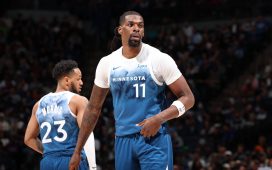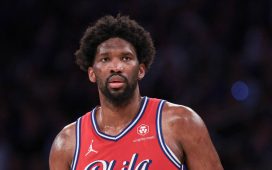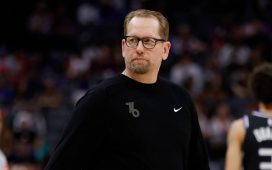Want more basketball in your inbox? Sign up for Marc Stein’s weekly N.B.A. newsletter here.
Even with that spotless 6-0 record in the N.B.A. finals, and 27 victories in the 29 playoff series he contested in the 1990s, Michael Jordan is unlikely to ever completely shut down the Greatest of All Time debate.
There will always be someone out there who prefers Bill Russell, Kareem Abdul-Jabbar or, yes, even LeBron James.
Yet such rampant winning does engender tremendous privilege. No other luminary in league history could have managed what Jordan just pulled off: His Airness made the N.B.A. stash exclusive behind-the-scenes footage of his Chicago Bulls’ sixth and final title run in 1997-98 for nearly 20 years, then had the 10-part documentary series that he finally blessed attract an audience of 4.9 million to 6.3 million for each serving.
As we got deeper and deeper into “The Last Dance,” criticism about the unparalleled control that Jordan had — with two of his closest business associates, Estee Portnoy and Curtis Polk, operating as executive producers — grew louder and louder. Our own Sopan Deb was on this point from the start, but nothing amplified the noise like the two-fisted blast to The Wall Street Journal from the noted documentarian Ken Burns, who asserted that Jordan’s influence over the project is “not the way you do good journalism” nor “the way you do good history.”
Those staggering audience figures, though, slammed home this reality: The basketball public was not looking for another Burns-ian documentary.
Viewers just wanted Jordan, in a chair, speaking for the cameras with greater candor than ever before, no matter what had to be sacrificed to put him there.
They wanted to remember how it had felt to bond over a shared basketball experience, in the midst of a global health crisis, knowing it remained unclear how soon the N.B.A. playoff reality show that we counted on every April, May and June could come back to fill that void. Even today’s players were tweeting about it:
We needed it and got swept up in it — even the crusty sportswriters like me who, amid the Sunday night doubleheaders and corresponding Twitter-fests, were compiling a lengthy list of the docuseries’ shortcomings.
Questions will persist about the glorification of Jordan’s bullying of teammates, even when it so plainly crossed the line with Scott Burrell (and others), and why it went unchallenged for 10 hours of storytelling. The same holds for the dearth of voices speaking up for the late Bulls General Manager Jerry Krause — while Jerry Reinsdorf completely dodged tough questions about why he, as the Bulls’ owner, didn’t assert his authority (or spend more freely) to keep a dynastic team together.
The constantly shifting timeline, back-and-forth from the 1997-98 season to various chapters in Jordan’s past that built up to his final season in Chicago, was an oft-cited source of viewer consternation. The total avoidance of Jordan’s own parenting, given the depths of his bond with his father, James, was another sizable hole, as was Jordan’s refusal to acknowledge his role in keeping Isiah Thomas off the United States Olympic team in 1992 — something he had previously acknowledged in Jack McCallum’s 2012 book about the Dream Team.
Yet I can’t co-sign the notion that the production, as some say, is merely an infomercial for No. 23’s legacy. It is not a definitive, balanced retelling from the Burns school, but Jordan’s aforementioned frankness, pouring out of three interviews conducted by the director Jason Hehir over roughly eight hours, will give it an everlasting gravitas.
To convince Jordan to grant the requisite sitdowns, and ultimately to admit that he could be a tyrannical teammate, Michael Tollin of Mandalay Sports Media, an executive producer of “The Last Dance,” made it a big part of his pitch in June 2016 that Jordan needed this documentary now. This would be Jordan’s ideal opportunity, Tollin explained, to properly educate a new generation of consumers, namely those buying his sneakers who had never seen him play.
I remain convinced that Jordan was motivated by LeBron’s gains in the G.O.A.T. debate more than anything. James had just led the Cleveland Cavaliers to the championship by overturning a 3-1 series deficit to the 73-win Golden State Warriors when Jordan gave his blessing in June 2016. As Tollin also told us in an April 17 article previewing the docuseries, Jordan committed to the project on the same day that the Cavaliers were being feted in Cleveland with a championship parade.
Then again, why protest?
Your humble newsletter curator has never been a Jordan worshiper, but I delighted in the return of N.B.A. appointment television as much as anyone, especially since it was so caked in nostalgia. I loved the flashbacks to the 1980s, my favorite N.B.A. decade, and Chicago’s old uniforms with the delicious script lettering and short-sleeved sweat jackets. I got tingly every time I heard the Bulls’ best-of-all-time intro music: “Sirius” by The Alan Parsons Project.
Most of all, I loved the unvaulted-at-last footage of interactions that we would have never otherwise seen: Jordan, Ron Harper and Burrell on the bench in Paris; Jordan and his Eastern Conference teammates speaking so openly (and critically) about a young Kobe Bryant — “the little Laker boy” — shortly before tipoff of the 1998 All-Star Game at Madison Square Garden; Jordan crossing paths with then-Pacers Coach Larry Bird after Chicago crushed Indiana’s N.B.A. finals dreams in a taut Game 7. The way M.J. mercilessly ribbed Larry Legend like no one else could about having extra time to work on his golf game will stay with me.
I wanted even more of that footage that has been locked away for so long, but Hehir was in an unenviable position. Before even getting to what second-guessers like me craved, he had to answer to ESPN, Netflix and the N.B.A. on top of Jordan’s camp. One more challenge: Moving the documentary up from its planned June release, to satiate desperate customers deprived of the N.B.A. playoffs, meant rushing to finish the final two episodes under duress. Episode 10 didn’t get wrapped up until last week.
The overwhelming commercial success of the series ensures that the door has been flung wide open for follow-up projects. Brace yourself for documentaries, podcasts and books that promise to take a more exacting look at, say, Jordan’s worrisome gambling habits or his reluctance to speak about political and societal issues — with interview subjects willing to be more critical than the ones we saw.
The trouble with forthcoming entries from what is bound to be billed as “The Real Last Dance” genre is that none of them will have anything close to this level of cooperation from Jordan. Hehir and Co. had to do so much on Jordan’s terms to get that cooperation, but to deliver His Airness after years of virtual seclusion?
Even Krause would have to concede that it was a trade anyone in the N.B.A. would have made.
This newsletter is OUR newsletter. So please weigh in with what you’d like to see here. To get your hoops-loving friends and family involved, please forward this email to them so they can jump in the conversation. If you’re not a subscriber, you can sign up here.
You ask; I answer. Every week in this space, I’ll field three questions posed via email at marcstein-newsletter@nytimes.com. (Please include your first and last name, as well as the city you’re writing in from, and make sure “Corner Three” is in the subject line.)
Q: In my opinion, there is a clear-cut way to honor David Stern’s legacy: Name the Rookie of the Year Award after him. How many handshakes did Stern give out all those years on draft night? — Steven Katz
The N.B.A.’s answer to the Supporters’ Shield in Major League Soccer, named after David Stern, could be awarded to the team with the best regular-season record. — Steve Shernicoff
Give the David Stern Award to the premier foreign-born player every season in honor of the game’s growth globally under Stern’s watch. — Bob Purcell, Carlsbad, Calif.
The N.B.A. draft could renamed as the David Stern N.B.A. draft — because you can’t think about draft night in the N.B.A. without thinking about him. — Daniel Duignan
Stein: As promised, I am sharing more suggestions from readers about the best way for the N.B.A. to pay tribute to David Stern, who died Jan. 1 at age 77.
It still feels as though the bulk of the ideas presented simply aren’t big enough to properly reflect the impact Stern had during his 30-year run as commissioner. The draft ideas come the closest, but it’s a challenge that won’t be easily solved for a league that has already dedicated major honors to Larry O’Brien (Stern’s predecessor whose name is on the N.B.A.’s championship trophy), Maurice Podoloff (whose name is on the league’s regular-season Most Valuable Player Award), Bill Russell (N.B.A. finals M.V.P.) and Kobe Bryant (All-Star Game M.V.P.).
The floor remains open for submissions.
Q: I kept looking for a reference to Allen Iverson to explain the big photo of him in last week’s newsletter but found none. Why was that picture included? — Nancy Feve
Stein: May 7 marked 18 years since Iverson’s famed rant during the 2002 playoffs in which he responded to questions about his practice habits and used the word “practice” more than 20 times. Because the first answer in last week’s Corner Three section was devoted to the subject of practice facilities and N.B.A. workout routines during the coronavirus crisis, we decided to connect the two in tribute to the recent Iverson anniversary.
Perhaps it wasn’t as obvious as we presumed, but even the newsletter team can’t resist whimsy on occasion.
Q: Are you complaining? Be happy we have something to watch and don’t be ungrateful. — @changeyotune from Twitter
Stein: You heard zero tweeted complaints from me Saturday about the live Bundesliga soccer on our screens. I have nothing but admiration for the players who had to generate their own intensity, without the help of a crowd, after such a long and disorienting layoff — and with as much concern as hope in the air.
But I did expect more from the broadcast of the Borussia Dortmund-Schalke match, especially at halftime, because a good broadcast is even more important now without fans in attendance to generate atmosphere.
The Bundesliga is in the final year of its current contract with Fox as its United States rights-holder. The league has thus known since the fall, long before the coronavirus outbreak, that Fox was no longer producing its own pre- or postgame shows or halftime content.
I understand that Bundesliga officials had countless details to fret about in putting together Saturday’s six-match slate. I have also noted this insight from my former ESPN colleague Ian Darke, who was forced to call one of Saturday’s games from his home in England for BT Sport and urged viewers to “cut all commentators a bit of slack” because the broadcasting conditions were so fraught with peril.
But Bundesliga officials knew well in advance that Fox has been doing the bare minimum all season and, challenging as it may have been, they could have arranged for some sort of halftime show — with score updates at the very least — to go out on its world feed just as the matches did.
As the first sports league of global stature to come back after suspending play in mid-March, Bundesliga soccer had a clearer runway than ever before to make a big impression on an American audience. This was a lost opportunity.
213
When Germany’s Bundesliga resumed play over the weekend, becoming the first top-flight league for a contact team sport to restart its season during the coronavirus pandemic, only 213 people were allowed inside each stadium. At the nine games contested Saturday, Sunday and Monday, 98 people were permitted on and around the field — including each 18-player squad, coaching staffs and ball kids — and 115 in various sections of the stands (such as security and medical personnel and members of the news media).
The N.B.A. is still planning detailed protocols that it would institute upon resuming the 2019-20 season and has not yet determined the specific number of people who would be granted entry to the closed-door games.
78.9
The N.B.A. completed 78.9 percent of its regular-season schedule, or 971 of a possible 1,230 games, before play was suspended on March 11.
71
Only 71 days elapsed between Michael Jordan’s final N.B.A. game, with the Washington Wizards on April 16, 2003, and the Cleveland Cavaliers’ selection of LeBron James with the first pick in the N.B.A. draft on June 26, 2003.
7
Despite his initial fears that the coaching change from Doug Collins to Phil Jackson in 1989 would take the ball out of his hands more than he could stomach, Michael Jordan led the league in scoring in each of his seven full seasons under Jackson.
20
Wednesday will mark 20 years since the death of Malik Sealy, the St. John’s star who played for four N.B.A. teams. Sealy was 30 on May 20, 2000, when his vehicle was struck by a pickup truck traveling on the wrong side of the road as he rode home from a birthday celebration for Kevin Garnett, his Minnesota Timberwolves teammate and close friend. Garnett wore No. 2 in Sealy’s honor when he played for the Nets in 2013-14 and for half of the 2014-15 season.







